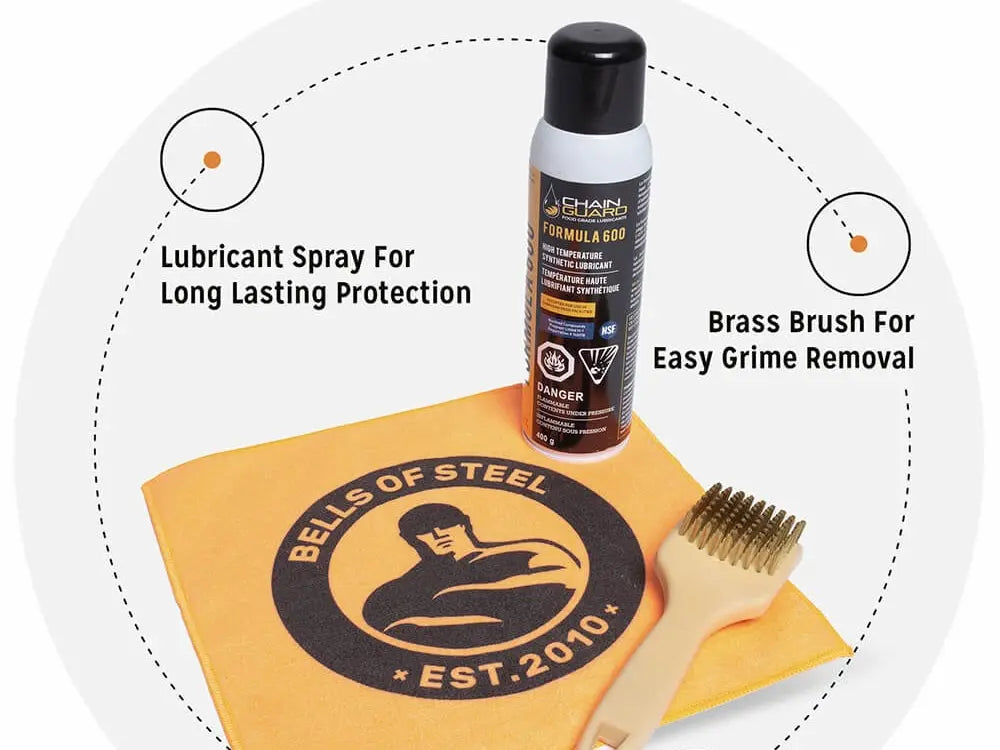Oh, bare steel. Nothing beats the feeling of raw steel in your hands as you’re clangin’ and bangin’. And while the feeling and grip of bare steel are practically unmatched, keeping the rust-fairies away can be a full-time job — especially in humid conditions.
This is because unlike barbells with a protective coating, like black zinc or cerakote, a bare steel barbell is, well, bare. Plus, there’s a lot of misinformation out there about what products you should use to tackle your bare steel barbell rust. Let’s simplify things, so you can get your bar cleaned fast and get back to lifting heavy!
IMPORTANT: This article is specifically for how to clean a bare steel barbell. Using the methods below on a coated barbell (black zinc, cerakote, etc) could potentially damage the finish. Here are the tools that you need to remove your bare steel barbell rust:Most of these can be found in your average barbell cleaning kit. You know that stiff, metal brush that you’d use to scrape off caked-on gunk from your car parts? Yeah, don’t you DARE use that on your barbell. Nylon bristle brushes are what the cool kids use nowadays. Since they get the job done without the risk of permanently scratching your bar (or dulling the knurling), this is definitely the best brush to use.
Pro tip: If you’re going to use a wire brush anyways, then at least make sure it’s a brass wire brush.This is the softest metal that will remove rust, without damaging your barbell. You have a bunch of options here: 3-in-1 oil, WD-40, Simple Green. The list really goes on, and on (and on). We won’t waste your time on explaining why the other options aren’t great choices.
Instead, we’ll simply recommend 3-in-1 oil for three reasons: it’s cheap, it won’t gunk up your bar, and you can buy it (almost) anywhere. This one will be used to wipe up excess lubricant, so just make sure it’s clean. It doesn’t have to be brand new. You wouldn’t want bacon grease and crumbs on your barbell, right? This one will be used to give your barbell a quick wipe at the very end of cleaning, and after each workout as a quick touch-up.
A microfiber towel has the best material since it won’t leave little fuzzies behind. Unless you love the feeling of oil on your hands, use some disposable gloves. Seriously, you’ll thank us later. Getting your bare steel barbell rust removed comes down to six simple steps:
- Remove bar from rack
- Raise up your bar
- Initial brushing
- Apply lubricant
- Scrub away
- Wipe off excess lubricant
You should absolutely remove the bar from your rack instead of cleaning it in your workout area. Picture this caked on your barbell: old crusty chalk, lubricant drippings, dried sweat, dead skin cells.… you get the point. Scraping off these nasties from your barbell over your workout area, especially if you have a lifting platform, is kinda gross.
But beyond the nastiness-factor, any lubricant drippings could turn your lifting area into a slippery surface. Definitely not good! If you can, bring your barbell outside to clean it. Unless it’s winter in Canada, of course — better luck in 9 months, eh? Since your barbell isn’t in your rack anymore, you’ll need to raise it up off the ground by a few inches to make the barbell’s shaft easier to clean.
Put a piece of 4x4 wood under each collar or elevate it on a workbench, either option can work. Now, it’s time to put those gloves on! Pro tip: If you’re cleaning your barbell on the floor or outside, an easy and cheap way to prop up your barbell is to use spring collars.
Whether or not you’ve got an obscene amount of nasties caked into your bar, give it a good brushing with your nylon bristle brush before applying the lubricant. Doing this will lift up old, crusty bits and will make your next steps a little easier. Next, go ahead and apply your lubricant (3-in-1 oil) to the bar. It’s usually easiest to apply it in streaks along the knurling. Just a touch-up cleaning job? Stick to a lighter application. Have a huge build-up of rust? Lay it on thick.
Grab your nylon brush once more and start scrubbing a section of your barbell with the power of the Energizer Bunny. Your goal is to work the lubricant along the knurling, so there’s an even layer to help penetrate any rust spots. Generally, stick to one 12” section of your barbell before moving onto the next 12” section.
This will help ensure each section gets a consistent focus. Finally, bring out your old rag and give your bar a good wipe. This will help sop up any extra lubricant that would otherwise make gripping the bar difficult.
Finally, use your microfiber towel for a finishing touch to remove any residual lubricant and fuzzies from the old rage. After doing this, you should have a pristine barbell! Bare steel barbell patina is a thin, consistent layer of rust that forms very slowly on the surface of your bar. It results in a light copper-like finish on the shaft and sleeves, which doesn’t rub off onto your hands.
Although this is technically a sign of rust, the bare steel barbell patina rarely (if ever) results in any kind of damage to a barbell since it’s so mild.= In our opinion, it adds a beautiful aesthetic to your barbell — show it off with pride!
Bare steel barbells are loved for their timeless looks and awesome knurling. And although they come with some extra maintenance to keep rust at bay, cleaning a bare steel barbell is straightforward. Do you have that fabled bare steel barbell patina? Drop us a picture, we’d love to feature your bar!



